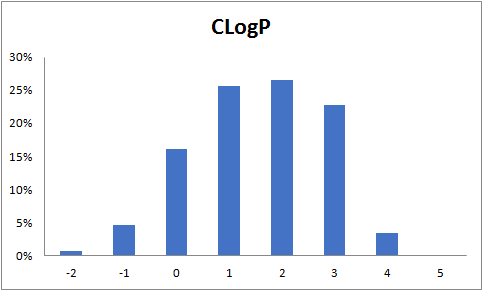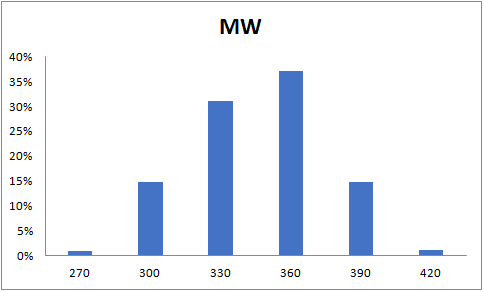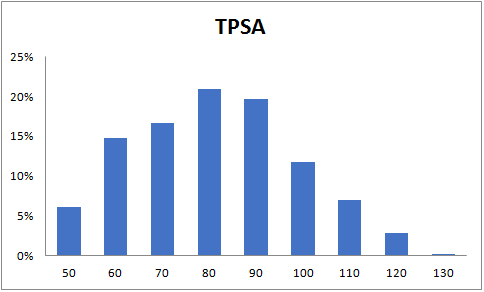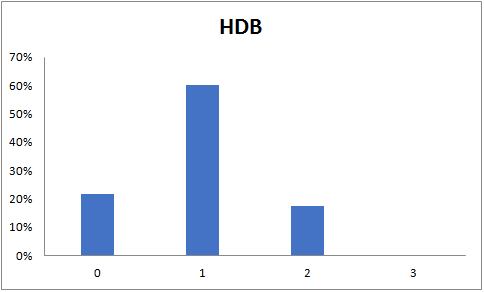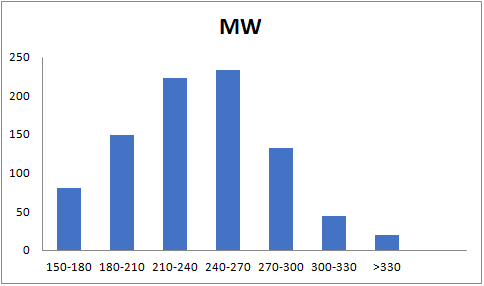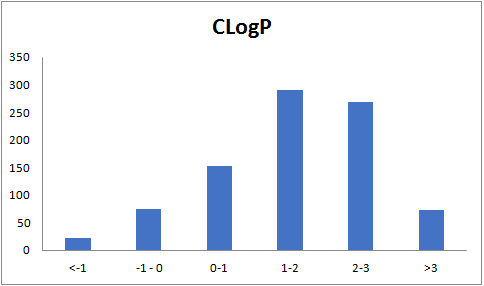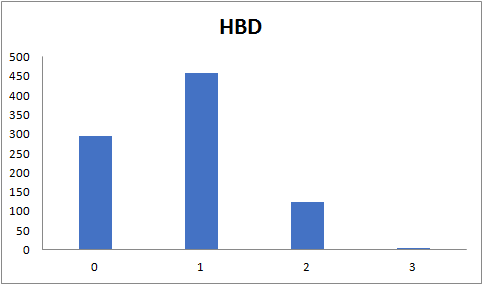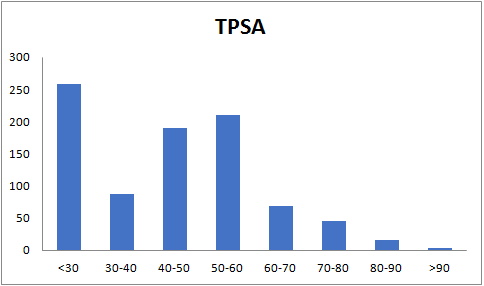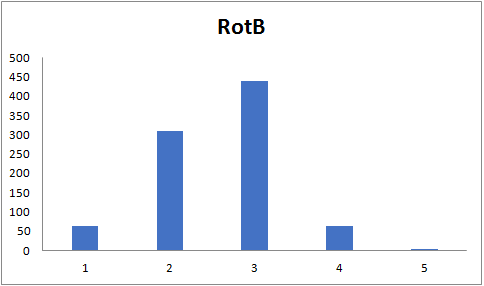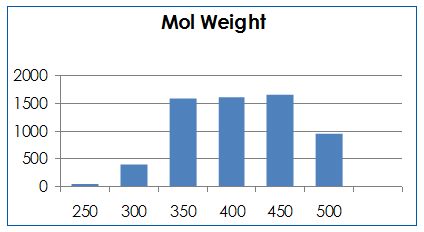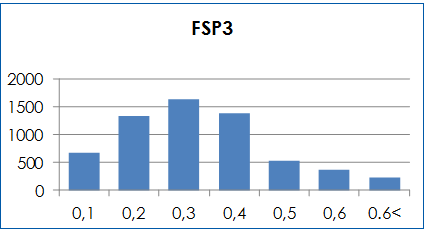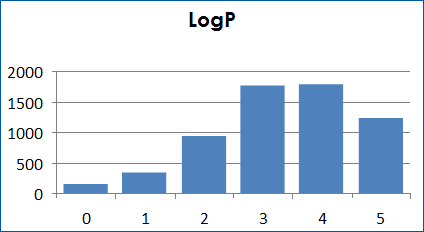Special diverse selection of frequent hitters
320 compounds
Pan-Assay Interference Compounds (PAINS) are the most recognized filters among medicinal chemists. Since first publication in 2010 by John Bell these filters have become industry standard in Drug Discovery. While carefully removing all PAINS-related compounds from Enamine libraries we realized that these compounds can be very useful in HTS assay set-up & validation.
Special diversity set of PAINS available for prompt delivery in various plated formats including the most popular listed below:
Typical Formats
PAINS Library is available for supply in various pre-plated formats, including the following most popular ones:
Catalog No.
PAINS-320-0-Z-10
Compounds
320
1 plate
Amount
≤ 300 nL of 10 mM of DMSO solutions
Plates and formats
1536-well Echo LDV microplates, first and last four columns empty, 1280 compounds per plate
Price
Catalog No.
PAINS-320-10-Y-10
Compounds
320
1 plate
Amount
≤ 10 µL of 10 mM DMSO solutions
Plates and formats
384-well, Echo Qualified LDV microplates #001-12782 (LP-0200), first and last two columns empty, 320 compounds per plate
Price
Catalog No.
PAINS-320-50-Y-10
Compounds
320
1 plate
Amount
50 μL of 10 mM DMSO solutions
Plates and formats
384-well, Greiner Bio-One plates #781280, 1,2 and 23,24 columns empty, 320 compounds per plate
Price
*We will be happy to provide our library in any other most convenient for your project format. Please select among the following our standard microplates: Greiner Bio-One 781270, 784201, 781280, 651201 or Echo Qualified 001-12782 (LP-0200), 001-14555 (PP-0200), 001-6969 (LP-0400), C52621 or send your preferred labware. Compounds pooling can be provided upon request.
Download SD files
Library design
The design is based on substructural motifs of known PAINS compounds. We used originally reported PAINS filters to identify a set of over 80k in-stock compounds. This set was clustered using fingerprint-based approach and Tanimoto similarity distance calculations. The most populated clusters with at least 5 compounds were extracted and one representative example was selected from each cluster resulting in a library of 320 compounds. The library of most diverse 320 PAINS is available in plate format for your convenience. Examples are given below.
Key features
- Represents the most common false positives
- Substructure & scaffold diversity
- All compounds suitable for storage as DMSO solutions
Example of structures and their specific PAINS filters
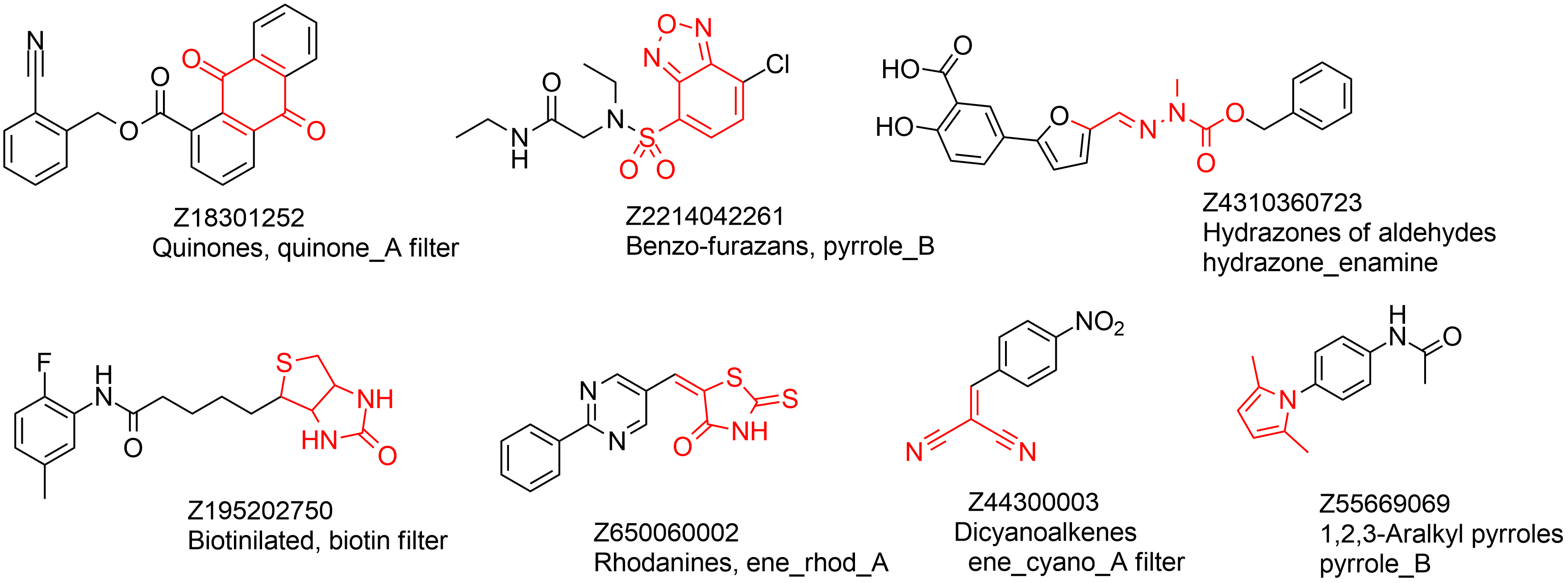
Diversity Libraries
CLOUD-299
Size
299
compounds
Description
Represents the diversity of structures and molecular targets of all FDA-approved chemical entities (Nat Chem Biol 13 (2017), 771–778)
BRL-2405
Size
2 405
compounds
Description
Actives with extensive target classes’ coverage and the broadest possible therapeutic areas applications – from CNS agents and anti-infectives to anticancer drugs, steroids and molecular glues.
FAD-1123
Size
1 123
compounds
Description
Most relevant selection of drugs in one formulation/no duplicates. Contains WHO List of Essential Medicines including Lapatinib and latest approved drugs such as Tivozanib, etc.
Bioactive sublibrary
BAC-1282
Size
1 282
compounds
Description
Compounds with referred biological activity for repurposing or investigation of new pathways and mechanisms
PSL-5760
Size
5 760
compounds
Description
Library of cell penetrated compounds and their closest analogs. Covers diverse therapeutic areas from antitumor, neurology and antibacterial to aging diseases.
PAINS-320
Size
320
compounds
Description
Frequent hitters with most diverse scaffold selection – from small hydroquinone and other covalent modifiers to polyfluorinated highly lipophilic molecules and dyes.
Focused Sets
Designed for easy and efficient exploration of novel protein targets
800 compounds
Fully functionalized probes are designed to speed up and simplify the early stages of drug development. The introduction of the diazirine photo-crosslinking moiety along with the presence of a functional acetylene group allows the screening of compounds directly in cells. Initially described in the Cell paper by Ben Cravatt this approach has been adopted by other research groups to a number of successful projects, including reported by GSK researchers ‘direct-to-biology’ high-throughput chemistry screening platform.
Enamine currently has over 6 000 fully functionalized compounds in stock and more than 1 million molecules in REAL Database.

The most diverse compounds have been selected and sorted into a small library, which has been pre-plated for the most convenient and fast delivery to our clients.
Typical Formats
Catalog No.
FFP-800-10-Y-20
Compounds
800
3 plates
Amount
10 µL of 20 mM DMSO solutions
Plates and formats
384 well, Greiner Bio-One microplates 781280, first and last two columns empty, 320 compounds per plate
Price
Catalog No.
FFP-800-50-Y-10
Compounds
800
3 plates
Amount
50 µL of 10 mM DMSO solutions
Plates and formats
384 well, Greiner Bio-One microplates 781280, first and last two columns empty, 320 compounds per plate
Price
Catalog No.
FFP-800-100-Y-10
Compounds
800
10 plates
Amount
100 µL of 10 mM DMSO stock solutions
Plates and formats
96 well, Greiner Bio-One microplates 651201, first and last columns empty, 80 compounds per plate
Price
*We will be happy to provide our library in any other most convenient for your project format. Please select among the following our standard microplates: Greiner Bio-One 781270, 784201, 781280, 651201 or Echo Qualified 001-12782 (LP-0200), 001-14555 (PP-0200), 001-6969 (LP-0400) or send your preferred labware. Compounds pooling can be provided upon request.
Download SD file
Key features
- Discovery of novel tractable protein targets
- Identification of the binding site of the POI
- Screening directly in cells
- Easy hit confirmation via LC-MS
- Next-generation libraries can be rapidly synthesized through parallel chemistry
This fully functionalized library has been designed based on the fragments with experimentally confirmed solubility in aqueous PBS at 1 mM concentration. The most commonly used alkyl diazirine photoaffinity tag was used for the library. Minimalistic diazirine photocrosslinker rapidly generate carbene upon UV-irradiation (typically 340-360 nm; 302 nm also can used). Generated carbene intermediate rapidly reacts with adjacent amino acid residues or is quenched by water. Interesting fact is that photocrosslinking captures wider range of residues comparative to electrophilic libraries. This leads to greater number of ligandable pockets that can be explored. An alkyne tag enable use of the library in ‘FFF’ workflows in cells. The library contains some reference compounds reported in the literature. In addition, we try to cover as much structural diversity as possible to have different chemotypes and pharmacophores within a limited number of compounds.
Examples of structures in the library

Characterized by a new HTS thiol-reactivity assay
960 compounds
Electrophilic Covalent Probe Library is aimed at the discovery of new inhibitors for cysteine-containing proteins. The library was developed by our collaborators at Weizmann Institute of Science (WIS), London lab and XChem group at Diamond Light Source. The design process of this library is described in the paper. All fragments were evaluated for thiol-reactivity and screened against 10 cysteine-containing proteins.
We refined a set of molecules initially proposed in the paper by removing compounds found to be promiscuous binders or highly reactive in the screening of several proteins.
Typical Formats
Catalog No.
ECPL-960-10-Y-100
Compounds
960 3 plates
Amount
10 µL of 100 mM DMSO solutions
Plates and formats
384-well plates Greiner Cat. No 781280, first two and last two columns empty, 320 cpds per plate
Price
Catalog No.
ECPL-960-25-Y-20
Compounds
960 3 plates
Amount
25 µL of 20 mM solutions in DMSO
Plates and formats
384-well plates, 1,2 & 23,24 columns empty, 320 compounds per plate
Price
Catalog No.
ECPL-960-50-Y-20
Compounds
960 3 plates
Amount
50 µL of 20 mM solutions in DMSO
Plates and formats
384-well microplates, Greiner Cat. No 782270, 1, 2, 3 and 4 columns empty, 320 compounds per plate
Price
Catalog No.
ECPL-960-100-X-20
Compounds
960 12 plates
Amount
100 µL of 20 mM solutions in DMSO
Plates and formats
96-well plates, Greiner Cat. No 651201, 1 & 12 columns empty, 80 compounds per plate
Price
Catalog No.
ECPL-960
Compounds
960
Amount
Custom
Plates and formats
Any custom format
Price
Download SD files
Key features
- Experimentally evaluated
- No over reactive and promiscuous covalent binders
- Initial SAR data based on small clusters
- Ease of chemistry for fast follow-up
For most convenient and fast delivery Electrophilic covalent probe library is available in versatile pre-plated formats and can be delivered within a week only! This library has also been evaluated for stability in DMSO and storage in solutions for at least 2 years.
Representative examples of cluster centroid molecules


Designed for discovery of new Nav1.7 channel blockers
5 440 compounds
Sodium voltage-gated ion channel considered to be an important component in nociception. Therefore, selective Nav1.7 channel blockers are considered as important novel analgesics.
Analyzing the structures of recently developed ligands several main features have been identified:
- the most abundant are relatively flat aromatic cores;
- presence of highly polar backbone fragments/moieties (e.g. CONH2, SO2NHR, polar heterocycles, etc);
- compounds lay squarely in the middle of drug-like chemical space.
A set of substructure queries and 2D-fingerprintes based on found common structural motives and pharmacophores was used in searching Enamine screening collection to result in 5 440 compounds after application of medchem filters. The Nav1.7 Targeted Library is rich in compounds bearing saturated backbones that can be often seen in structures of other ion-channel blockers. All compounds meet requirements of Ro5, and 67% compounds are considered lead-like.
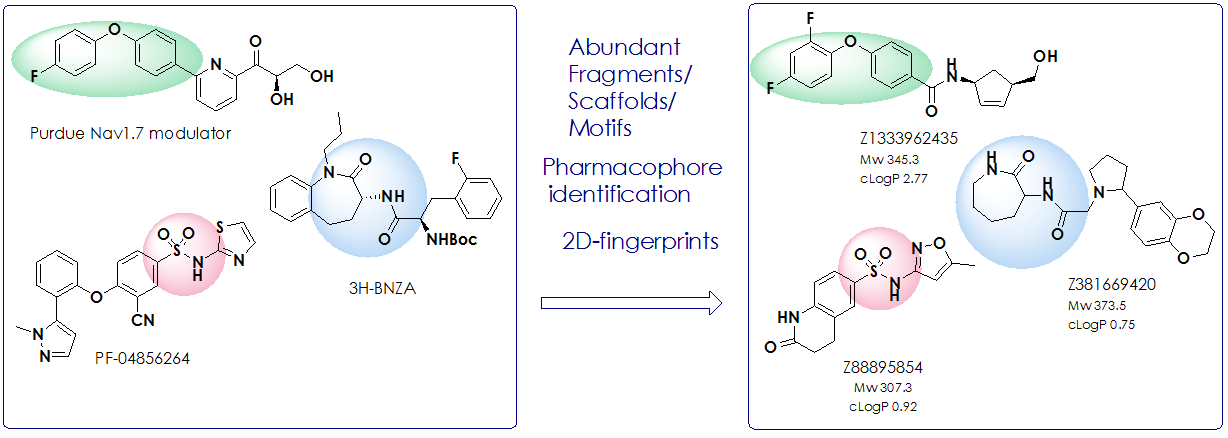
Download SD file
Library code: SICL-5440
Version: 24 May 2020
5 440 compounds
sublibrary of ICL-36



